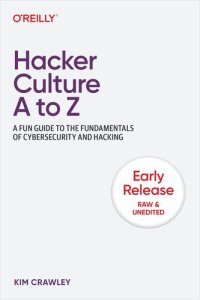
Ebook: Hacker Culture A to Z: A Fun Guide to the Fundamentals of Cybersecurity and Hacking (2nd Early Release)
Author: Kim Crawley
- Genre: Computers // Networking: Internet
- Year: 2023
- Publisher: O'Reilly Media
- Language: English
- epub
Hacker culture can be esoteric, but this entertaining reference is here to help. Organized from A to Z and written by a longtime hacker, this fun, conversational reference introduces you to key people and companies, fundamental ideas, and milestone films, games, and magazines. From phreaking to deepfakes, from APT to zombie malware, grasping the terminology is crucial to understanding hacker culture and history.
If you're just getting started on your hacker journey, you'll find plenty here to guide your learning and help you understand the references and cultural allusions you come across. More experienced hackers will find historical depth, wry humor, and some perhaps surprising facts about familiar cultural touchstones.
Computer programming languages can be classified according to how much abstraction they have from a CPU’s instruction set. The most abstracted high-level programming languages are the most human readable and intuitive, such as Perl and Python. Low-level programming languages (assembly languages, by contrast, speak the most directly to the CPU. Most are assembly languages, the most esoteric of programming languages. There are different assembly languages for different types of CPUs.
No computer is 100% secure. The closest we can get is by airgapping: that is, restricting access to a computer’s data as much as possible by not having any connections to any networks whatsoever. Not to the internet, not to any internal networks, not even to any printer devices or network-attached storage. That’s the most literal network-security definition, at any rate.
If you want to do a really proper job, you should physically remove any network interface cards and disable any USB ports and optical drives that aren’t absolutely necessary for the computer’s authorized use. Those aren’t computers, but they are potential cyberattack surfaces: places where a threat actor could send malicious data. Ideally, an airgapped computer should also be in a room protected by excellent physical security, including locked physical doors that require the user to authenticate.
If you're just getting started on your hacker journey, you'll find plenty here to guide your learning and help you understand the references and cultural allusions you come across. More experienced hackers will find historical depth, wry humor, and some perhaps surprising facts about familiar cultural touchstones.
Computer programming languages can be classified according to how much abstraction they have from a CPU’s instruction set. The most abstracted high-level programming languages are the most human readable and intuitive, such as Perl and Python. Low-level programming languages (assembly languages, by contrast, speak the most directly to the CPU. Most are assembly languages, the most esoteric of programming languages. There are different assembly languages for different types of CPUs.
No computer is 100% secure. The closest we can get is by airgapping: that is, restricting access to a computer’s data as much as possible by not having any connections to any networks whatsoever. Not to the internet, not to any internal networks, not even to any printer devices or network-attached storage. That’s the most literal network-security definition, at any rate.
If you want to do a really proper job, you should physically remove any network interface cards and disable any USB ports and optical drives that aren’t absolutely necessary for the computer’s authorized use. Those aren’t computers, but they are potential cyberattack surfaces: places where a threat actor could send malicious data. Ideally, an airgapped computer should also be in a room protected by excellent physical security, including locked physical doors that require the user to authenticate.
Download the book Hacker Culture A to Z: A Fun Guide to the Fundamentals of Cybersecurity and Hacking (2nd Early Release) for free or read online
Continue reading on any device:

Last viewed books
Related books
{related-news}
Comments (0)